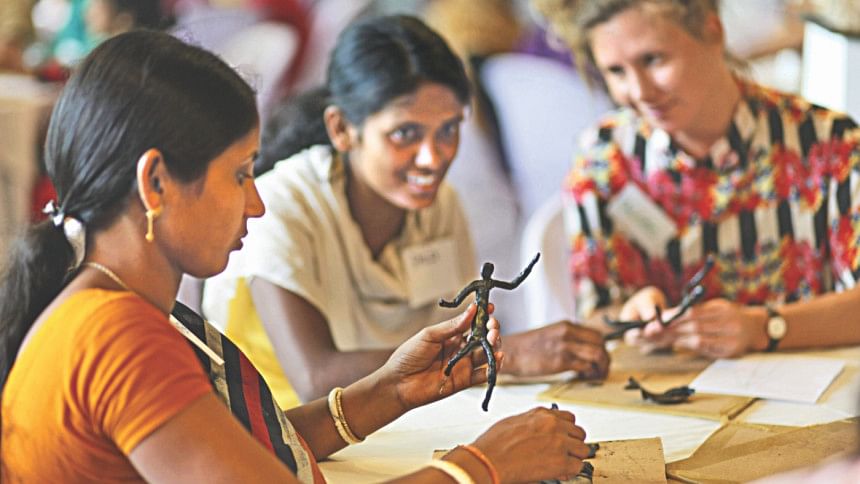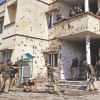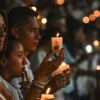Sculptures for survival

Shepu Rani Das, 20, was busy braiding wax hair on a statue of black molten wax, while her sister Shilpi Rani Das, 18, looked on and recounted their rescue from under the debris of Rana Plaza.
"I used to work as a machine operator on the sixth floor at New Wave Style. I was rescued after three days," said Shilpi describing how her left arm had to be amputated later as a result of injuries from the eight-story building collapse on April 24, 2013.
The catastrophe also left a lasting mark on Shepu, who worked in the same line as her sister. "Her right ankle bone had to be cut off to bring her out," said Shilpi, as her sister lifted a part of her sari to show the injury.
Despite the trauma the two sisters carried, the wax structures they were working on spoke of joy, a happy life.
In fact, 34 other female survivors of the disaster, which claimed the life of more than 1,100 people and injured thousands, were expressing aspirations of their lives by creating wax figures at an art workshop.
It was the second such event organised by the Embassy of Denmark, a day before the International Women's Day was observed on March 8 worldwide.
Through art, these women can escape and get relief for a while from the trauma they experienced three years ago, explained Farhana von Mitzlaff, founder and chairperson of Meena, an NGO that works for Rana Plaza victims.
However, expression through art became more than a therapy when Farhana met proprietor of Dhamrai Metal Crafts Sukanta Banik, who was friends with Danish art educator Kirsten Fugl, also the mother of Danish ambassador to Bangladesh, Hanne Fugl Eskjær.
They thought of a way in which the survivors, who received assistance from Meena at different times since 2013, could create an investment for their future through art.
In 2015, Meena, The Danish Embassy in Dhaka, Dhamrai Metal Crafts, photographer Abir Abdullah, and Kirsten joined hands and conducted a day-long workshop titled “Sculptures for Survival” with 40 Rana Plaza survivors and victim's families.
The participants of the workshop created statues which were turned into clay moulds and later cast into metal sculptures that told the stories of their struggle and dreams.
The final products, which told 10 such stories, and were finished with the help of Dhamrai Metal Crafts, were later used to raise a fund of about Tk 10 lakh through an exhibition, said Farhana.
Hanne said they thought of investing the money in something to empower the women so that they could create their own source of income.
They came up with the idea of establishing a sewing workshop, with the support of a Bangladeshi RMG company, Esquire Group, and its Danish partner, who donated 17 machines and provided technical expertise, design and skills training.
"Many of the women could not go back to work after the building collapse because of physical and mental trauma. Sometimes employers were not willing to recruit the survivors," said Hanne.
Mossamat Asma Begum, who was a machine operator in Phantom Apparel, had tried to go back to work but could not take the eight-hour-long stressful shifts in factory.
"My back hurts a lot," she said, adding that the atmosphere of a formal factory brought back the dreaded memory of April 24, 2013.
Instead, Asma attended a sewing course at Meena and now has a hand-run sewing machine at home. She now takes order from people in her locality and earns about Tk 2,000 a month.
After the first fund raising event, the women wanted to have individual sewing machines, but Kirsten was able to persuade them to invest in a workshop where they could come and work and support each other.
"If you go out individually, then you set up small competing factories," she said, explaining how she encouraged the women to work together.
Farhana explained that in the workshop they could work in small shifts and take orders requiring simple work such as production of shopping bags.
However, the workshop is in need of further funding for electrical installations, and also orders from clients.
That's why the second sculpture workshop. And this year SHaKo, a women artist's association in Bangladesh, joined hands to put together an art exhibition and sculpture workshop again.
This year 24 sculptures, of which 16 were made by the Rana Plaza survivors and the rest by the eight female artists of SHaKo, would be on display at an exhibition at Bengal Lounge in Gulshan on April 21 at 6pm .
"The women from Rana Plaza are no longer victims. They have survived. Now they are strong. They participate and involve themselves in raising fund for their life. They are taking responsibility for their own future," said Kirsten.
The sculpture Shepu and Shilpi made, shows two sisters dancing. It reflects a joyful future the two sisters looked forward to.
The joy shone in Shilpi's eyes when she told the correspondent proudly how she rented a quarter in Savar alone, this time not to work in a garment factory but to go back to studying.

 For all latest news, follow The Daily Star's Google News channel.
For all latest news, follow The Daily Star's Google News channel. 








Comments